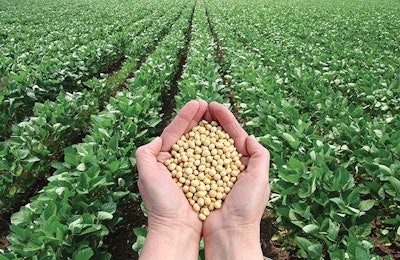
Soybean meal remains the protein par excellence for the majority of animal feeds, worldwide. No other feed protein surpasses it in terms of volume, quality and price for value.
In monogastric animals, soybean meal is the reference protein source. Cereals might change by region, but soybean meal is an international commodity familiar to all feed professionals. About 50 percent of total soybean meal volume goes to poultry, with pigs getting another 25 percent, and the remaining 25 percent is shared among all other animal species. Thus, when we discuss soybean meal, we focus mainly on poultry and pigs.
Anti-nutritional factors
Why soybean meal, and not just raw soybeans? First, because soybeans are not cultivated for their protein — this is the inevitable byproduct — but rather for their valuable oil. Second, because soybeans contain anti-nutritional factors (ANF) and allergens that cause severe digestive upsets, leading to reduced animal performance. As it happens, extracting oil involves some form of thermal processing that partially neutralizes these negative components; but this is never enough for young animals.
Young animals are very sensitive to ANF and allergens, especially young chicks and piglets that suffer from trypsin inhibitor activity (TIA), a protease inhibitor. This is perhaps the reason why TIA is the most widely used laboratory test in the evaluation of soybean products for young animals. If TIA is low enough, then all other ANF (but not the allergens) are within acceptable limits. Research has shown that the relationship of young animals to TIA intake is linearly negative as far as growth is concerned. Other quality tests (like urase activity or KOH solubility index) are more suitable for soybean products destined for older animals. Nevertheless, these latter tests remain less expensive, and as such, they are more widely known and used by feed manufacturers. In reality, however, TIA is the correct index for young animal feeds.
The lesser-known issue of allergens
Perhaps this whole discussion would have been pointless — as most readers are already aware of the role of ANF — if it was not to serve as the introduction to the lesser-known issue of allergens. Although widely researched and acknowledged in the 1980s and 1990s, this issue remains today a near-forgotten aspect of soybean quality. Back then, it was discovered that chicks, piglets and even pre-ruminant calves — all previously naïve (unexposed) to soybeans — will develop a severe auto-immune transient hypersensitivity when first exposed to soybean proteins. Researchers are still unsure how to classify this phenomenon, but we can easily compare it to a food allergy akin to peanut allergy in humans.
Learn more: Understanding specialty soy proteins in a global market
In monogastric animals, this hypersensitivity is rather milder, with pigs and chicks developing oral immunity within a couple of weeks (calves do not develop such immunity, however). But, even a transient hypersensitivity is damaging enough, because it happens during the most critical days of the life of a chick (newly hatched), piglet (newly weaned from milk) or calf (undeveloped rumen). As a result, we observe severe gut inflammation that leads to destruction of the epithelial architecture and functionality, including reduced immune status through severe oxidative stress — the harbinger of all kinds of disease issues. In other words, the intestines are inflamed, the cells are sloughed off and water leaks out. And as cellular tight junctions loosen up, toxins enter the organism, causing further damage. This is when opportunistic bacteria that produce toxins (Escherichia coli and Clostridium perfringens, for example) cause the most damage. End result: enteric disorders, such as severe diarrhea in piglets or necrotic enteritis in chicks, lead to dehydration, morbidity and even death.
The whole issue of hypersensitivity is caused by glycinin and beta conglycinin, which are the allergens, but also the main soybean proteins. Although there have been efforts to genetically modify these proteins to neutralize their allergenic properties, normal soybeans are still mainstream, and they will remain so. The main method nutritionists have employed to face the issue of hypersensitivity has been the reduction of soybean products in diets for sensitive animals. This is why animal proteins, and other refined vegetable proteins, are used traditionally in diets for very young animals. But, and this is a major problem, these alternative protein sources remain too expensive for modern production methods, and as such, some professionals prefer to ignore the issue, hoping it will be ascribed to so many other problems that plague young animals. It does not have to be this way.
Non-aggressive soybean proteins
Today, and to my knowledge, there are two sources of soybean proteins that bypass (if not completely, at least to any practical degree) the issue of hypersensitivity to allergens — at least in chicks and piglets. Although both products are more expensive than plain soybean meal, they ensure that if any intestinal disorders occur, soybean proteins will not be blamed.
Soy protein concentrate is a refined protein source containing about 65 percent crude protein. Its production includes an aqueous ethanol extraction step that denaturates allergenic soybean proteins. It does not alter the nutritional value (such as overcooking does), but it reduces hypersensitivity reaction to virtually zero levels. As such, soy protein concentrate is often used as the main vegetable protein instead of normal soybean meal. But it is rather expensive, and not readily available throughout the world. Here it should be noted that soy protein isolate (more than 80 percent crude protein) may be more refined than soy protein concentrate, but it does not undergo the same production process, and as such, it remains as allergenic as the original material.
The second, more modern, product that bypasses the issue of hypersensitivity is that of enzymatically treated soybean meal. Enzymes (added as pure enzymes or through a bacterial/yeast culture; these facts remain closely guarded trade secrets) can denaturate soybean proteins to the point where they no longer pose a threat to young, sensitive animals. Indeed, recent research has shown that certain high-quality products (there are always less-expensive fake copies of everything in life) can be compared to soy protein concentrate, and the old protein reference of fish meal (again of high quality) today is either unavailable or too expensive even for the most high-value chick and piglet diets.
As it happens, these enzymes do not neutralize all ANF (even soy protein concentrate contains a good amount of them). But, apparently, the concentration of ANF in plain soybean meal is not the major issue with young animals. In fact, low levels of plain soybean meal are used almost universally along with these more refined soybean protein sources. One may hypothesize that it is not even the mere presence of allergenic proteins, but rather their absolute concentration that creates the basis for a negative reaction. In fact, other ingredients may protect young animals, or help them recover faster, but this is a more general discussion pertaining to piglet feed design.
For this discussion, it is important to realize that apart from ANF, which must be minimized, young chicks and piglets should receive diets with less untreated soybean proteins to avoid the issue of allergens (Table 1). To this end, treated soybean products can not only prevent transient hypersensitivity inflammation, but they also may actually enable a good level of plain soybean meal to be used without worry — a hypothesis that requires some researching.

Table 1. By using treated soybeans, animals are exposed to less antigenic and other harmful compounds that cause overoxidation, which is an indication of reduced health and impaired immune system.

















